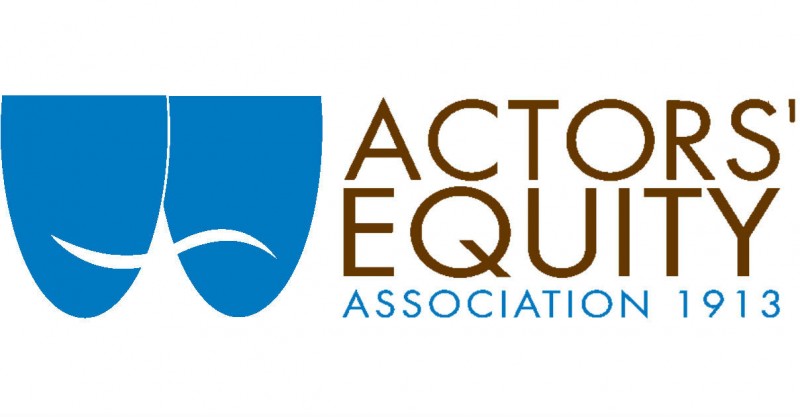
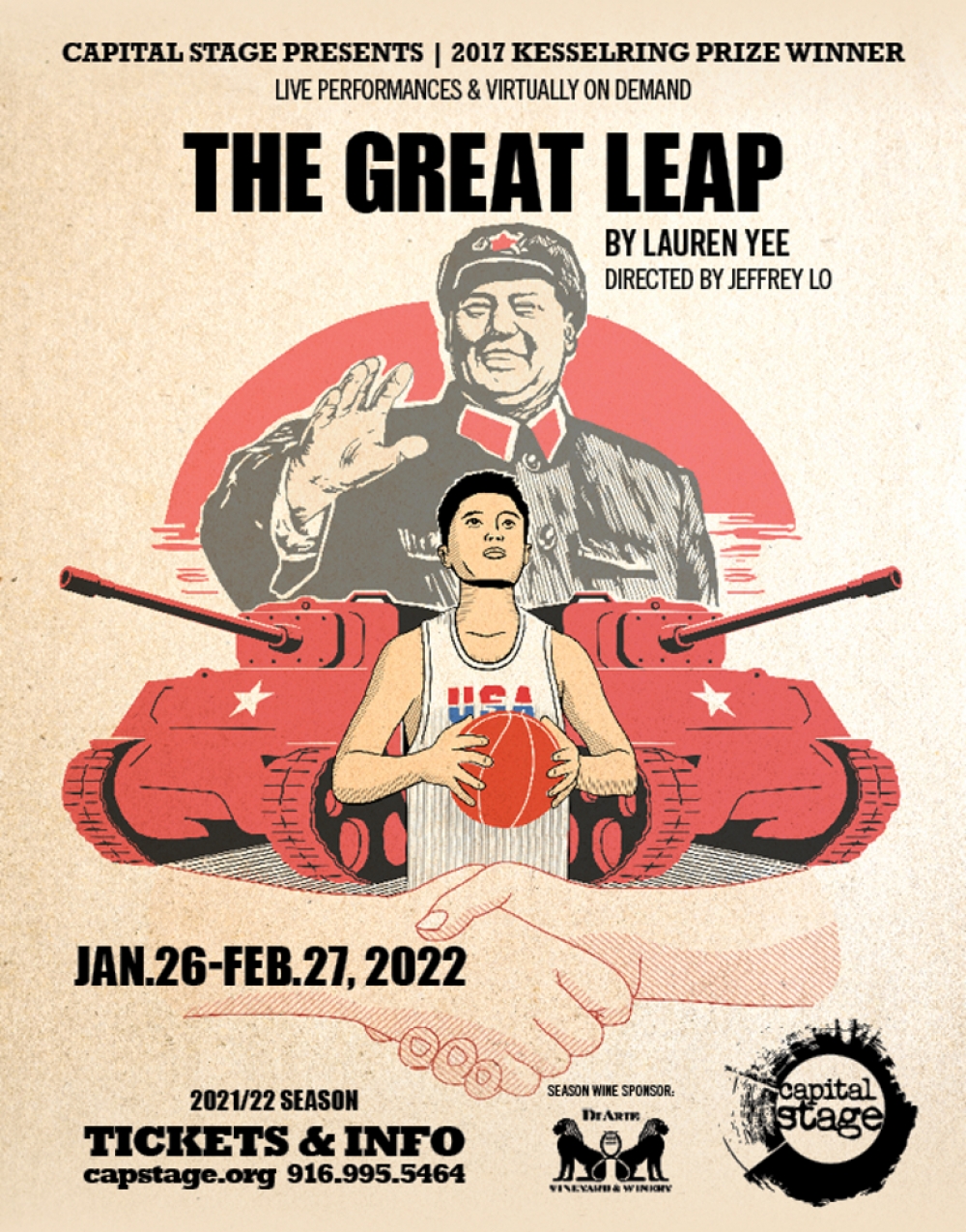
Artistic Director Michael Stevenson &
|
|||||||
| by Lauren Yee | |||||||
|
Directed by Jeffrey Lo |
|||||||
|
Live Theatre & Virtually On Demand January 26 - February 27, 2022 Performance Length: 2 hours, 1 intermission |
|||||||
|
|||||||
|
Eric Broadwater |
|
||||||
|
Lighting Designer |
|||||||
| Sound Designer/Projections Engineer Ed Lee |
Properties Designer Rebekah Fegan |
||||||
| Projections Designer Christopher Fitzer |
|||||||
|
Stage Manager |
|||||||
| Assistant Stage Manager Katherine Cannon* |
|||||||
 |
|||||||
|
THE GREAT LEAP is presented by arrangement with Concord Theatricals on behalf of Samuel French, Inc. www.concordtheatricals.com The Great Leap was originally developed and produced by Denver Center for the Performing Arts Theatre Company, Chris Coleman, Artistic Director. New York Premiere Presented by Atlantic Theater Company “The Great Leap” was developed with the support of The Playwrights’ Center Developed in the New Strands Residency, a program of the American Conservatory Theater, Carey Perloff, Artistic Director – Peter Pastreich, Executive Director A workshop production of The Great Leap was presented by New York Stage and Film & Vassar at the Powerhouse Theater, Summer 2017. |
|||||||
| *Member Actors' Equity Association | |||||||
Follow Us:
OUR MISSION
Capital Stage’s mission is to entertain, engage and challenge our audience with bold, thought provoking theatre.
THINGS TO KNOW
COVID-19 SAFETY:
To attend a performance everyone in your party must present proof of vaccination for COVID-19 (with a second dose at least 14 days prior to the date of the performance), plus a booster (if eligible and 6 months after your final dose) with a valid photo ID. Masks also must be worn in the theatre and interior lobby areas at all times. NO FOOD OR BEVERAGES ARE ALLOWED INSIDE THE THEATRE.
VIDEO/PHOTOS:
Recording and photography of any kind are prohibited at Capital Stage.
CELL PHONES:
Patrons are asked to turn communication devices off upon entering the theatre.
LATE SEATING & RE-SEATING:
Due to the design of our theatre, we cannot guarantee seating for late arrivals or for patrons who leave the theatre during the performance. As a courtesy to our artists and our audiences, late arrivals will be seated in a suitable location by our staff if possible and at the appropriate intervals.
REFRESHMENTS:
Only concession items purchased in the Wine & Dessert Bar are allowed. Concessions will be limited and can only be consumed while on our Patio. NO FOOD OR BEVERAGES ARE ALLOWED IN THE THEATRE.
CHILDREN:
Capital Stage is noted for bringing intimate bold productions to our region and we encourage young adults to experience a live performance. Children age sixteen and up are welcome at Capital Stage unless specifically noted in the production’s description.
WHEELCHAIR SEATING:
Seating locations at Capital Stage for patrons using wheelchairs or with a disability are located in the first row. Tickets for these seats may be purchased in person or by calling the Box Office at 916-995-5464.
RESTROOMS:
Restroom facilities are located in the lounge behind the Wine & Dessert Bar.
INFORMATION:
Brochures and information about upcoming Capital Stage productions and events are available in the box office or by visiting capstage.org.
Capital Stage is a member of Actors' Equity Association, the Union of Professional Actors and Stage Managers in the United States.
Capital Stage is a member of Theatre Communications Group (TCG), the national organization for the American theatre.
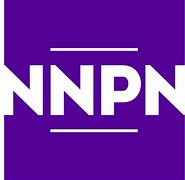
Capital Stage is a member of the National New Play Network, the country’s alliance of leading nonprofit theaters that champion the development, production and continued life of new plays.
Capital Stage is a member of Blue Star Theatres, offering discounts to Military personnel, Military family members, and Veterans.
Setting
SETTING
San Francisco, California
Beijing, China
TIME
May 1989
Summer/Fall 1971 and June 1989
About The Play
By Stephanie Tucker, PhD
During the Cultural Revolution, they [Chairman Mao, et al] got rid of Western classical music and anything else Western was frowned upon, with only a handful of exceptions. One was basketball.
Alexander Wolff, Big Game, Small World (2002)
For all the Jeremy Lins (on and off the court).
Playwright’s dedication
Set in San Francisco and Bejiing, THE GREAT LEAP tells the story of a 17-year-old Chinese American basketball player, who, in 1989, begs Saul Slezac, the coach of University of San Francisco’s basketball team, to let him join the squad on their trip to China to play against Bejiing University’s team in a rematch of sorts between the two coaches—Saul and Wen Chang—whose last meeting was in 1971.
In this play, titles, times, sets, dedications, all are significant. Jeremy Lin, for example, is a Californian, who, one of the few Asian Americans to play in the NBA, was the first to win an NBA championship.
The play’s title refers to “The Great Leap Forward,” China’s disastrous five-year plan, launched by Mao in 1958, in order to solve the country’s economic woes. To do so, he attempted to convert the country from an agrarian society to a communist one, a social experiment which resulted, for a number of complex reasons, in some 40+ million Chinese deaths—due in large part from an horrendous human-made famine.
Another outcome of the Great Leap Forward: the Soviet Union’s withdrawal of support of the People’s Republic of China, leading to border skirmishes that eventually prompted the PRC to amend relations with the United States in 1971—and “Ping-Pong Diplomacy” with the United States, so named for the U.S. ping-pong team’s visit to mainland China in 22 years—the same year President Richard Nixon sent Secretary of State Henry Kissinger on a mission to China to arrange a presidential trip, which famously happened in 1972.
1989 was similarly momentous: After the death of Hu Yaobang, a former Communist leader who had become a symbol of democratic reform, thousands of students marched through Tiananmen Square to protest communist rule and call for a more democratic government. Over the next three months, the protests increased, when by May, the numbers grew to an estimated 1.2 million. The Chinese government halted all live American news telecasts from Bejiing, and reporters were forbidden to photograph or videotape the demonstrators or the Chinese troops who, on June 4th, reached Tiananmen Square, in an effort to put an end to the uprisings. The Chinese army fired on the students and civilians, slaughtering countless people. An official death toll was never released. The next day, a lone protester, wandered into the square and stood in the street blocking a column of Chinese tanks, which when they swerved to avoid him, he followed, keeping his body directly in their route, for several minutes. He was never identified, but known for all time as “the Tank Man.”
About The Playwright
By Stephanie Tucker, PhD
Born and raised in San Francisco, Lauren Yee went to Yale, majoring in English and Theater Arts, after which she attended UC San Diego’s MFA playwriting program. She currently lives with her husband, a lawyer, in New York City.
Of the nine or more plays she’s written, CAMBODIAN ROCK BAND, THE GREAT LEAP and KING OF THE YEES are her best known, and most frequently performed—the last two inspired by her father. Her awards are numerous, and impressive—including being a finalist for the prestigious Susan Smith Blackburn for THE GREAT LEAP.
Of this work, she has written:
The play is about my father, but I wrote it for my younger brothers. In THE GREAT LEAP, Manford is a Chinese-American kid who keeps bumping up against people who don’t believe in him or see limitations when they look at him. That’s not what I want for my brothers. My wish is that they move through the world unencumbered and be whatever they want to be.
Sponsors
>Cast
Creative Team
Jeffrey Lo
Michael Stevenson
Keith Riedell
Katherine Cannon*
Carlos Llontop
Wesley Apfel*
Kaitlin Weinstein
Andrew Fridae
Eric Broadwater
Michael Palumbo
Rebecca Valentino
Ed Lee
Christopher Fitzer
Rebekah Fegan
Samantha McLean Haas
Special Thanks
Donna Chipps
Ted Cobb
Jim Hensley, President Abbey Flooring, Inc.
Robert Mandelson
Production Staff
Production Manager/Asst. Stage Manager - KATHERINE CANNON*
Technical Director - CARLOS LLONTOP
Lead Carpenter - RICH KIRLIN
Scenic Charge Artist - SAMANTHA McLEAN HAAS
Sound Designer & Projections Engineer - ED LEE
Lead Electrician - MARI OYAIZU CARSON
Literary Manager/Dramaturg - STEPHANIE TUCKER, PhD.
Stage Manager - WESLEY APFEL*
Stage Management Production Assistant - KAITLIN WEINSTEIN^
Assistant to the Director - ANDREW FRIDAE^
Fight Choreographer - Matt K. Miller
Properties Assistant - ANA MUNTEAN^
Sound Assistant/Crew Swing - KAIDEN ZALDUMBIDE^
Lighting Assistant - RAND DOERNING^
Costume Assistant - CECILIA CASTILLO JUAREZ^
Projections Assistant - NICHOLAS RABORN^
Build Crew - RAND DOERNING^, ANDREW FRIDAE^, CECILIA CASTILLO JUAREZ^, RICH KIRLIN, ALEXANDER MARTINEZ, ANA MUNTEAN^, NICHOLAS RABORN^, KAITLIN WEINSTEIN^, KAIDEN ZALDUMBIDE^
COVID-19 Safety Managers - KATIE CANNON, ELIJAH PETERS, RUBY SKETCHLEY
Graphic Designers - DAN LYDERSEN, MISTY MCDOWELL
Photographer - CHARR CRAIL
Videographer/Editor - WESLEY APFEL, MISTY MCDOWELL
Webmaster - MISTY MCDOWELL
^ Capital Stage Apprentice | * Member Actors' Equity Association
Meet the Company
Tim Kniffin*
 Tim returns to Capital Stage, where he performed in THE NETHER and SLOWGIRL. He has performed throughout the San Francisco Bay Area, the Pacific Northwest, Dallas, Chicago, with early highlights performing in Poland in 1986 and The Kennedy Center in 1988. A few favorite roles include Atticus Finch in TO KILL A MOCKINGBIRD, Captain Von Trapp in THE SOUND OF MUSIC, Benedict in MUCH ADO ABOUT NOTHING, and Carl in the feature film BURN COUNTRY. Tim is eternally grateful to his family and friends, looks forward to his next project, AUGUST: OSAGE COUNTY at San Jose Stage.
Tim returns to Capital Stage, where he performed in THE NETHER and SLOWGIRL. He has performed throughout the San Francisco Bay Area, the Pacific Northwest, Dallas, Chicago, with early highlights performing in Poland in 1986 and The Kennedy Center in 1988. A few favorite roles include Atticus Finch in TO KILL A MOCKINGBIRD, Captain Von Trapp in THE SOUND OF MUSIC, Benedict in MUCH ADO ABOUT NOTHING, and Carl in the feature film BURN COUNTRY. Tim is eternally grateful to his family and friends, looks forward to his next project, AUGUST: OSAGE COUNTY at San Jose Stage.
Matthew Hanjoong
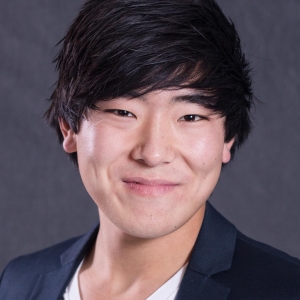 Matthew Hanjoong is a Sacramento State University graduate and a former Capital Stage Apprentice. Matthew is excited to be back with Capital Stage performing Lauren Yee’s THE GREAT LEAP live this time. Most recently, he was seen onstage for PlayGround SF’s Monday Night Playground performing in Jennifer Le Blanc’s NUTCRACKER SWEETS and was virtually seen in Playground SF’s Best of Playground Festival performing in THE ART OF SUFFRAGE. Matthew has also studied at UCLA with Academy Award Winner Tim Robbins and The Actor’s Gang.
Matthew Hanjoong is a Sacramento State University graduate and a former Capital Stage Apprentice. Matthew is excited to be back with Capital Stage performing Lauren Yee’s THE GREAT LEAP live this time. Most recently, he was seen onstage for PlayGround SF’s Monday Night Playground performing in Jennifer Le Blanc’s NUTCRACKER SWEETS and was virtually seen in Playground SF’s Best of Playground Festival performing in THE ART OF SUFFRAGE. Matthew has also studied at UCLA with Academy Award Winner Tim Robbins and The Actor’s Gang.
Edward Chen*
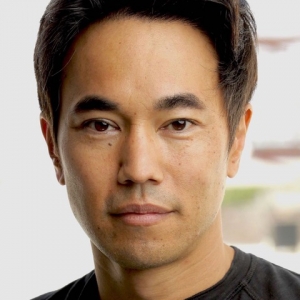 SF Bay Area born actor, Edward Chen, received a collegiate baseball scholarship and attended Cornell University where he discovered a passion for the performing arts. In addition to many roles in TV and film, Edward’s received critical acclaim for lead roles at top theatres (Boston Court, East West Players, South Coast Rep, Cygnet) Backstage.com wrote, “Holding fast to his every character, Chen takes not one false step onstage.” Acting conservatory trained in voice, movement, Alexander technique and more, Edward’s first love is theatre for its tight community, close collaboration with artists, and live intimacy with audience. In a society struggling to communicate honestly, the theatre allows character’s to finally speak the truth.
SF Bay Area born actor, Edward Chen, received a collegiate baseball scholarship and attended Cornell University where he discovered a passion for the performing arts. In addition to many roles in TV and film, Edward’s received critical acclaim for lead roles at top theatres (Boston Court, East West Players, South Coast Rep, Cygnet) Backstage.com wrote, “Holding fast to his every character, Chen takes not one false step onstage.” Acting conservatory trained in voice, movement, Alexander technique and more, Edward’s first love is theatre for its tight community, close collaboration with artists, and live intimacy with audience. In a society struggling to communicate honestly, the theatre allows character’s to finally speak the truth.
Nicole Anne Salle
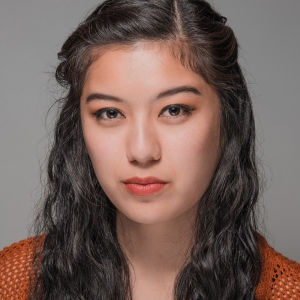 Nicole Anne Salle earned her BA in Theatre from Sacramento State University and is a former Capital Stage apprentice. She recently made her professional debut in Sacramento Theatre Company’s season 2021/2022 opener and regional premier, GLORIA: A LIFE, and was most recently seen at Capital Stage as Jane in MISS BENNET: CHRISTMAS AT PEMBERLEY. Favorite credits include Bethany in Capital Stage’s virtual production of RIPE FRENZY, and Patria in IN THE TIME OF THE BUTTERFLIES at Sacramento State.
Nicole Anne Salle earned her BA in Theatre from Sacramento State University and is a former Capital Stage apprentice. She recently made her professional debut in Sacramento Theatre Company’s season 2021/2022 opener and regional premier, GLORIA: A LIFE, and was most recently seen at Capital Stage as Jane in MISS BENNET: CHRISTMAS AT PEMBERLEY. Favorite credits include Bethany in Capital Stage’s virtual production of RIPE FRENZY, and Patria in IN THE TIME OF THE BUTTERFLIES at Sacramento State.
Jeffrey Lo
Michael Stevenson
Keith Riedell
Katherine Cannon*
Carlos Llontop
Wesley Apfel*
Kaitlin Weinstein
Andrew Fridae
Eric Broadwater
Michael Palumbo
Rebecca Valentino
Ed Lee
Christopher Fitzer
Rebekah Fegan
Samantha McLean Haas
ACTORS’ EQUITY ASSOCIATION (AEA)
Founded in 1913, this union represents more than 45,000 actors and stage managers in the United States. Equity seeks to advance, promote and foster the art of live theatre as an essential component of our society. Equity negotiates wages and working conditions, providing a wide range of benefits, including health and pension plans. AEA is a member of the AFL-CIO, and is affiliated with FIA, an international organization of performing arts unions. The Equity emblem is our mark of excellence.
Capital Stage Staff
MICHAEL STEVENSON - Artistic Director
PETER MOHRMANN - Co-Founder, Associate Artist
KEITH RIEDELL - Managing Director
KATIE CANNON - Production & Company Manager
MISTY MCDOWELL - Marketing Manager
AALIYAH PETERS - Audience Services Manager
CARLOS LLONTOP - Technical Director
ED LEE - Resident Sound Designer & Engineer
RICH KIRLIN - Lead Carpenter
LOGAN HELLER – Box Office Assistant
RUBY SKETCHLEY – Front of House Assistant
JAMIE JONES, GAIL RUSSELL, JANIS STEVENS – Associate Artists
KATHY DAVENPORT – Bookkeeping Assistant
DEEDEE WALKER – Volunteer Coordinator
RAND DOERNING, ANDREW FRIDAE, ANA MUNTEAN, KAITLIN WIENSTEIN, CECILIA CASTILLO JUAREZ, NICK RABORN, KAIDEN ZALDUMBIDE - Apprentices
ELIJAH PETERS, RUBY SKETCHLEY - COVID Safety Officers
Capital Stage Board Members
Chastity E. Benson
California State Association of Counties
Donnell Brown
National Grape Research Alliance
Dan Brunner, Treasurer
Arts Patron
Melissa Conner
Seed Communications Design
Kathryn E. Doi
Hanson Bridgett LLP
Sherry Hartel Haus
Downey Brand
Steve Koonce
Arts Patron
Kris Martin
Arts Patron
Kristi Quesada Mathisen
Sacramento Country Day School
Peter Mohrmann, Co-founder
Capital Stage
Lori Abbott Moreland
Arts Patron
Damaris L. Perez
Crowe LLP
Mike Tentis, Board President
UC Davis Strategic Communications
Peggy Wheeler
California Hospital Association
Board Emeritus:
Stephanie Gularte, Founding Artistic Director
Capital Stage
Clif McFarland
Mitchell Chadwick
Arlen Orchard
SMUD
Jonathan Williams, Co-Founder
Capital Stage
Julie Stark
Arts Patron
Tiananmen Square: What They Died For
By Andrew Fridae
CONTENT WARNING: GRAPHIC VIOLENCE
The massacre in Tiananmen Square on June 4th, 1989 was the Communist party’s reaction to months of protests. But what precisely were the goals of the protests, and how did they precipitate in a country with such a censorious, authoritarian government?
The former question is difficult to establish as the groundswell of protesters, much like the George Floyd protests in America in 2020, were diverse and decentralized, calling for broad reform. Many of these reforms had already been proposed by members within the party, centered around Hu Yaobang, who proposed increased elements of democracy in Chinese government, as well as a limitation to the influence of the Communist party over the government. But after Yaobang’s death on April 15, 1989, it became clear that such reform from within was not likely, catalyzing an enormous surge in protests nationwide, centering in Beijing.
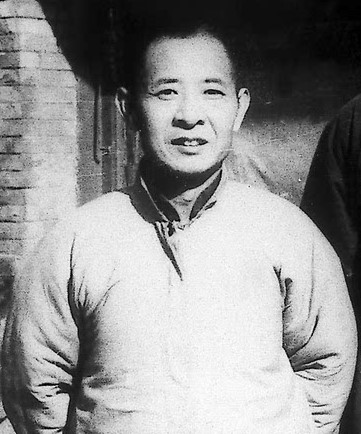
(Hu Yaobang, Former party Chairman and General Secretary, second in prominence only to Deng Xiaoping, a reformer whose death by heart attack led to national mourning and protest.)
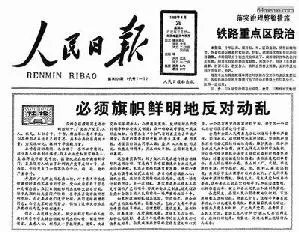
(The famous April 23rd Editorial in the People’s Daily, titled, “IT IS NECESSARY TO TAKE A CLEAR-CUT STAND AGAINST DISTURBANCES” in response to the protest)
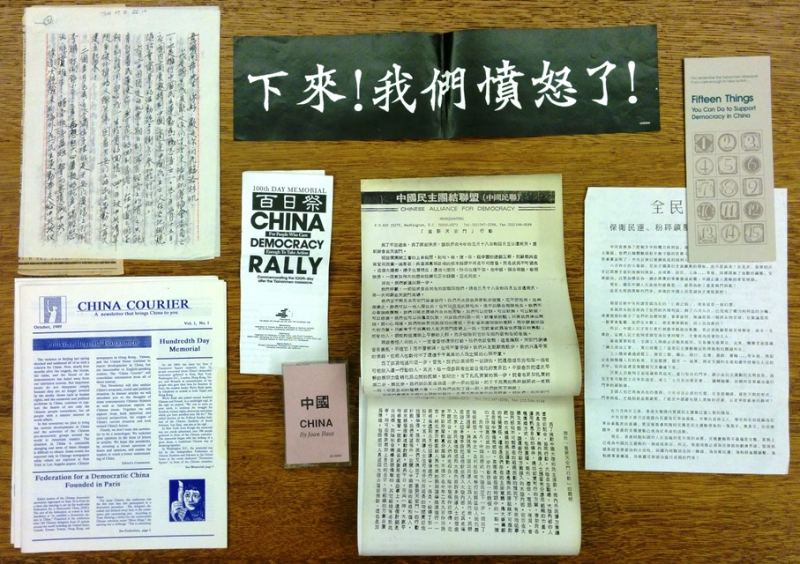
(Protest materials from the New York Public Library’s collection on the Tiananmen Square Protests. The banner at the top center reads: Get down! We are outraged!)
The latter question, how did these protests precipitate, is also complex, but a major contributor was the humble fax machine. Along with pamphlets and word of mouth, faxing was central to the development of a nationwide protest, and a worldwide struggle. When the massacre began too, faxes were used to get the message out amid massive censorship of global media’s access to reporting the events unfolding at the capitol. Faxes were harder to intercept or ‘tap’ than phone calls, and they existed in institutions of higher learning and journalism, which were hubs of the protest communities. Yet as a result of this massive censorship, many elements of the massacre remain unconfirmed and the precise fate of thousands, lost to history.
We are left to use our judgment and imagination filling in the gaps between photographs and film and firsthand accounts, and the pamphlets, banners, and faxes which yet survive. We have included for your consideration a few resources we feel illuminate these events.
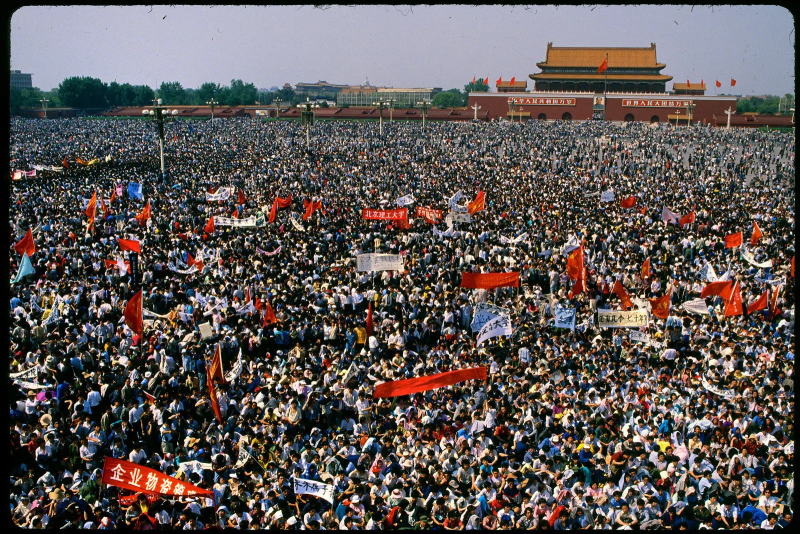
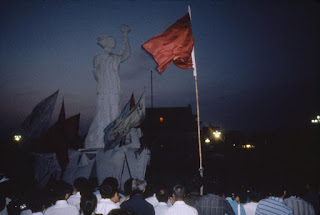
(Statue erected by protesters, called the Goddess of Democracy, photo taken around midnight on June 3rd, shortly before its destruction.)
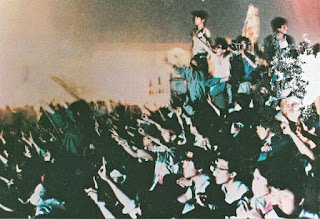
(Protesters defiant as the PLA closes in, early morning June 4th, shortly before violence erupts.)
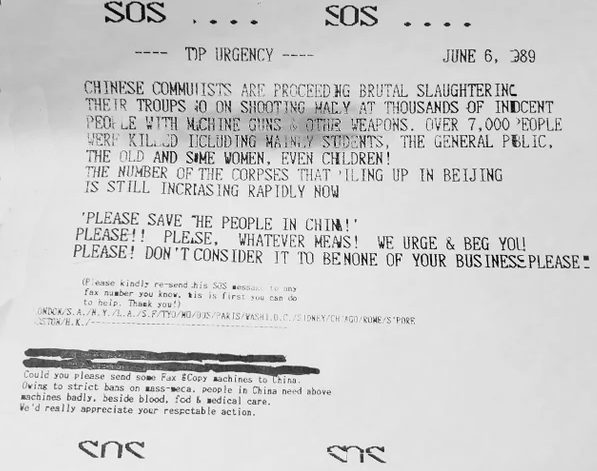
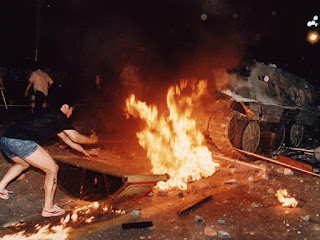
(Protesters burning APC 003 early June 4)

(Protesters rescuing soldiers from the APC)
The following is a cable from UK intelligence sent on June 5th, 1989 credited to Alan Ewan Donald. This cable is one of many reports that remain unconfirmed, and bears no copyright source information on Wikisource.
“...3. FACT. ON THE NIGHT OF 3/4 JUNE 27 ARMY WAS TO ATTACK FROM THE WEST WITH OTHER UNITS FROM SHENYANG MR. THE PLAN WAS THAT THE FIRST WAVE (SMR) WOULD ATTACK WITH NO WEAPONS. THE SECOND WAVE (SMR) WOULD ATTACK WITH WEAPONS BUT NO AMMUNITION. THE THIRD WAVE (SMR) WOULD ATTACK AS FOR SECOND WAVE BUT OFFICERS WOULD HAVE LOADED SIDE ARMS TO FRIGHTEN THE CROWD. THE FOURTH WAVE WOULD BE 27 ARMY WITH FULL EQUIPMENT AND AMMUNITION. THE FIRST ATTACKS OCCURRED AT MUCIDI AND SHILIPU. THE FIRST THREE WAVES WERE HELD BY THE DEMONSTRATORS AND SMR TROOPS TRIED TO PUSH BACK THE CROWDS TO LET 27 ARMY THROUGH. THEY FAILED AND 27 ARMY APCS OPENED FIRE ON THE CROWD (BOTH CIVILIANS AND SOLDIERS) BEFORE RUNNING OVER THEM IN THEIR APCS.
4. FACT. THE ENRAGED MASSES FOLLOWED IGNORING M/G FIRE TO NEXT BATTLE AT LIUBUKOU. APCS RAN OVER TROOPS AND CIVILIANS AT 65KPH IN SAME MANNER. ONE APC CRASHED AND DRIVER (A CAPTAIN) GOT OUT AND WAS TAKEN BY CROWD TO HOSPITAL. HE IS NOT DERANGED AND DEMANDS DEATH FOR HIS ATROCITIES.
5. FACT. ON ARRIVAL AT TIANANMEN TROOPS FROM SMR HAD SEPARATED STUDENTS AND RESIDENTS. STUDENTS UNDERSTOOD THEY WERE GIVEN ONE HOUR TO LEAVE SQUARE BUT AFTER FIVE MINUTES APCS ATTACKED. STUDENTS LINKED ARMS BUT WERE MOWN DOWN INCLUDING SOLDIERS. APCS THEN RAN OVER BODIES TIME AND TIME AGAIN TO MAKE QUOTE PIE UNQUOTE AND REMAINS COLLECTED BY BULLDOZER. REMAINS INCINERATED AND THEN HOSED DOWN DRAINS.
6. 27 ARMY ORDERED TO SPARE NOONE AND SHOT WOUNDED SMR SOLDIERS. 4 WOUNDED GIRL STUDENTS BEGGED FOR THEIR LIVES BUT WERE BAYONETED. A 3 YEAR OLD GIRL WAS INJURED BUT HER MOTHER WAS SHOT AS SHE WENT TO HER AID AS WERE SIX OTHERS WHO TRIED. 1000 SURVIVORS WERE TOLD THEY COULD ESCAPE VIA ZHENGYI LU BUT WERE THEN MOWN DOWN BY SPECIALLY PREPARED M/G POSITIONS. ARMY AMBULANCES WHO ATTEMPTED TO GIVE AID WERE SHOT UP AS WAS A SINO-JAPANESE HOSPITAL AMBULANCE. WITH MEDICAL CREW DEAD WOUNDED DRIVER ATTEMPTED TO RAM ATTACKERS BUT WAS BLOWN TO PIECES BY ANTI TANK WEAPON. IN FURTHER ATTACK APCS CAUGHT UP WITH SMR STRAGGLER TRUCKS, RAMMED AND OVERTURNED THEM AND RAN OVER TROOPS. DURING ATTACK 27 ARMY OFFICER SHOT DEAD BY OWN TROOPS APPARENTLY BECAUSE HE FALTERED. TROOPS EXPLAINED THEY WOULD BE SHOT IF THEY HADN'T SHOT OFFICER…”
If you would like to know more, we also recommend this excellent documentary on the tank man by Frontline: https://youtu.be/fHMZmthg-Vk
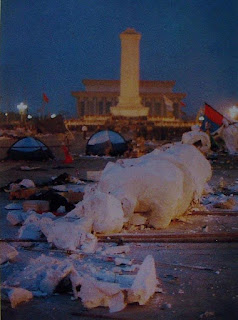
(Goddess of Democracy in ruins)

(A fatally injured protester with flower.)
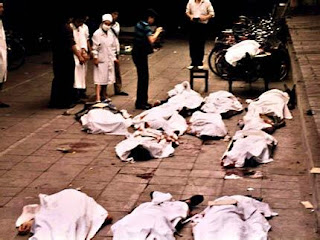
(One of many scenes of shrouded bodies.)
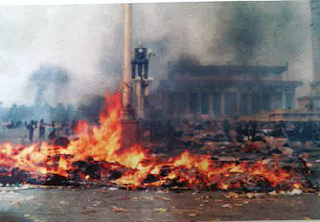
(Soldiers burned away wreckage and bodies in the square.)
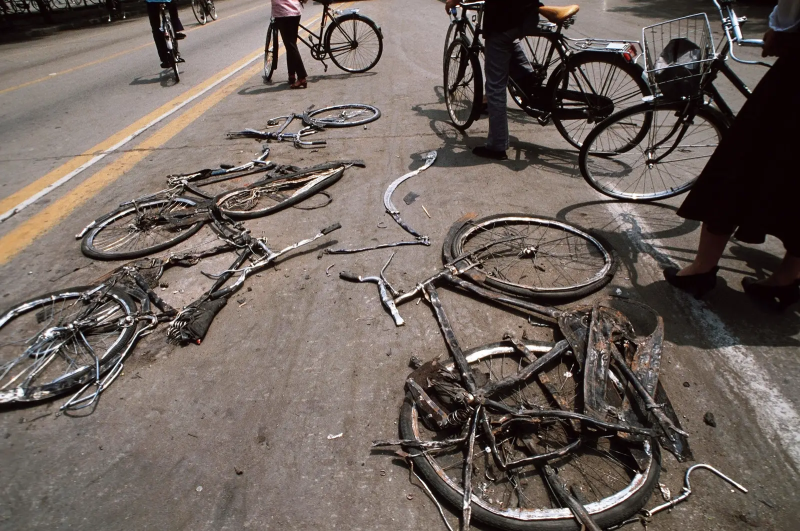
(Bicycles crushed by tanks)





